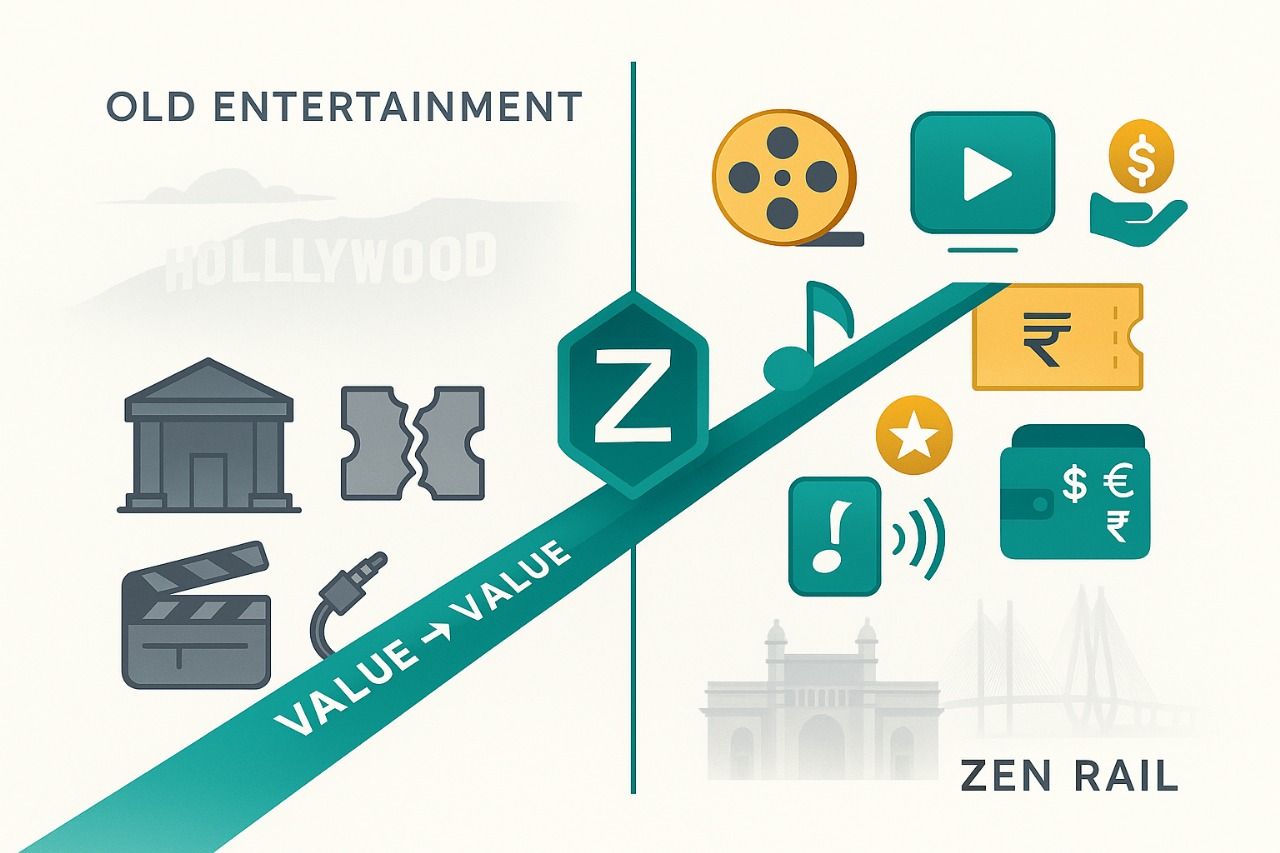
I’m building Zen and Atlas Rails around one simple idea: liquidity.
In plain language, liquidity is the ease with which value can move. If money is the blood of an economy, liquidity is the blood flow: fast, clean, and available wherever the body needs it. When liquidity flows, entrepreneurs ship faster, traders price better, savers earn more, and ordinary people get paid on time in the form they actually want.
Most technology pitches put features first. I put liquidity first. Every Zen vertical whether it is ZenPays, ZenOTC, ZenTrading, ZenTokenize, and ZenFinance, (and even the CEX, which will come later) they exist to source, route, price, and settle liquidity. Atlas Rails is the fabric that stitches them together into one simple experience. If you want a label for it, think of an analogy like LAAS: Liquidity-as-a-Service: neutral, reliable, permissionless at the edges, and engineered to make demand and supply meet in their truest, purest form.
I’m an Objectivist. That means I make decisions by reason, I build toward a clear purpose, and I respect the self-esteem of every individual who chooses to trade with me; no sacrifices, no vague promises, no hidden levers. Value for value, or nothing.
This post is kind of my blueprint of how I’m building Zen and Atlas Rails to make liquidity flow for decades to come.
The Real-World Pain: Where Liquidity Breaks Today
Before telling you what I’m building, I should tell you what I’m fixing. Anyone who has tried moving significant amounts of value across borders, assets, and banks knows these pains:
- Fragmentation
Your money, tokens, and credit lines are scattered across banks, exchanges, chains, and payment processors. Each island has different rules, limits, and cut-off times. - Pre-Funding & Idle Capital
You’re forced to park cash on multiple venues “just in case,” which means your capital sits idle. That’s dead weight on your balance sheet. - Slow Settlement
Wire cut-offs, T+2 (many times, more) settlement, compliance back-and-forths, reconciliation delays; hours when the market moves in minutes. - Opaque Pricing
Quotes move after you confirm. “Fees” appear in five places. Spreads widen with no explanation. You’re never sure if you got the best route. You’re forced to compromise. - Counterparty & Custody Risk
Centralized venues can halt withdrawals, freeze accounts, or change rules mid-trade. You discover “risk policies” after the fact. - FX & Off-Ramp Friction
You receive dollars, your suppliers want euros, your team needs payroll in local currency, your treasury prefers stablecoins; each conversion adds cost and delay. - Compliance as a Gate, Not a Path
The rules you’re happy to follow are enforced as stop signs, not guardrails. You meet requirements but still wait in line. Irrational KYCs burst your gut.
In short: liquidity is trapped in walled gardens. You pay in time, fees, and uncertainty.
My First Principle: The Trader Principle
The trader principle is simple: two parties exchange value voluntarily, because both gain. No coercion. No “someone must lose.” No “we pressed the red button in the back office to save ourselves.”
In markets, that principle turns into demand meeting supply at a price that both accept. When this happens cleanly, you get efficiency, fairness, and growth. When intermediaries block, distort, or hide the process, you get chaos and mistrust.
Atlas Rails exists to put the trader principle back at the center of every transaction. It does this by making demand and supply visible, reachable, and settle-able on neutral rails, without favoritism, with rules that don’t change mid-trade, and with custody choices that respect the individual.
What Is Atlas Rails (vis-à-vis that magic word “liquidity”?
Think of Atlas Rails as the financial internet for liquidity:
- Pipes that connect wallets, banks, exchanges, market makers, and liquidity pools.
- A switchboard that looks at your request (buy, sell, convert, pay, settle) and finds the best path across all connected sources.
- A rulebook that is known in advance: how quotes are routed, how fees apply, and how settlement happens.
- A ledger-aware fabric that works with fiat, stablecoins, crypto assets, and tokenized real-world assets without forcing you to care which engine is under the hood.
Atlas Rails doesn’t “hold the market.” It orchestrates the market you choose to tap.
Liquidity-as-a-Service (LAAS): What You Actually Get
When I say LAAS, I mean you can request liquidity like an API, and the rails do four things automatically and predictably:
- Discover the best liquidity (who has the other side of your trade, at what depth).
- Quote with clear pricing and path (which mix of venues/pools/sources delivers best execution).
- Commit with programmable settlement (atomic or near-atomic, with escrow/guarantees as needed).
- Settle in the asset and account you want (wallet, bank, pool), on your timeline.
You bring demand. Atlas finds supply. You approve. The system executes. No drama.
How Zen Verticals Plug In
Each Zen vertical does one job extremely well. Atlas Rails stitches them together into one flow.
- ZenOTC: Big, negotiated trades done cleanly; no slippage surprises. RFQ (request for quote) across multiple market makers + venues, with transparent fills.
- ZenTrading: Electronic execution, smart order routing, and risk tools for active traders. If you want to automate a strategy or hedge an exposure, ZenTrading is your cockpit.
- ZenPays: Move money for business: pay-ins, pay-outs, FX, recurring settlements. Accept in one asset, settle in another, reconcile automatically.
- ZenTokenize: Create tokenized assets with real cash flows and clear rights. Liquidity here means redemptions, secondary trading, and transparent NAV; not just a “token that exists.”
- ZenFinance and DEX: Treasury tools: yield options, credit lines, portfolio rebalancing. This is about using liquidity efficiently once you have it.
Atlas Rails is the neutral ground underneath. Verticals are specialists on top. Together, they make liquidity a utility you can turn on wherever you operate.
Where Does Liquidity Come From?
Anywhere there is supply:
- Market Makers posting two-sided quotes.
- Exchanges and AMMs with order books and pools.
- Banks and payment partners for fiat rails.
- Stablecoin treasuries and on/off-ramp partners.
- Our own curated pools and client inventory (with clear segregation and rules).
- Peer demand (your counterpart may be another customer whose demand offsets yours).
Atlas Rails doesn’t care who supplies - only that the route is best, the rules are clear, and the settlement is safe.
The Flow: How a Trade Actually Moves
In layman steps:
- You ask: “I want to convert 500,000 USDC to EUR in my bank by 4pm, best price.”
- Atlas scouts routes: MM quotes, exchange books, fiat FX partners, on/off-ramp slots.
- You see a route: “Best path is Pool A → OTC Fill → Bank FX Partner B. Fee X, rate Y, ETA Z.”
- You accept: One click or API call.
- Rails execute: Assets move across the chosen path, hedges are placed, settlement is coordinated.
- You settle: Your bank sees euros, your wallet shows receipts, your dashboard reconciles. Done.
Same pattern for a token buyback, a cross-border payroll, a large BTC/ETH swap, or a revenue share distribution on a tokenized asset. Demand in, supply matched, settled out.
Procurement & Availability: Pure Demand–Supply, Without the Games
I’ve seen and watched good businessmen long enough to know when “best execution” is a slogan. On Atlas Rails, it’s a mechanic:
- Multi-path discovery: The router doesn’t just check one venue; it checks all connected venues, OTC books, and pools that fit your constraints.
- Path scoring: We score paths by total landed cost, time to settle, counterparty profile, and inventory impact. You can weight what matters to you: “Give me fastest,” or “Give me cheapest.”
- No dark repricing: Quotes are binding within clear time windows. No “gotchas” after you click.
- Atomic intent: When possible, your intent (e.g., “have USDC → want EUR bank funds”) is treated as a single unit of work. The system ensures each step is either completed or rolled back safely.
- Inventory intelligence: If we can fill your demand from matched client flow (someone else wants the opposite), we do it: tight pricing, minimal market impact.
This is how demand and supply should meet. No favoritism. No hidden levers. Just the trader principle, encoded.
Let’s see Some Use Cases
Here are simple, real-world examples of how this works across Zen’s verticals:
1) A High-Net-Worth Swap Without Market Shock (ZenOTC + Atlas)
You want to move $5 million worth of BTC into ETH. A straight market order would move the price against you.
- We RFQ multiple market makers and check order books.
- The router builds a laddered fill across OTC + exchange pairs to reduce impact.
- You see one executable quote.
- Atlas settles BTC out, ETH in, with hedge coverage along the path.
- Your price is tight, your exposure is controlled, and the market barely notices.
2) A Merchant That Sells Globally (ZenPays + Atlas)
Your online store sells to 50 countries.
- Customers can pay in card, bank, or stablecoin.
- You choose to settle daily in your home currency (say GBP), with an option to keep 10% in USDC as working capital.
- Atlas converts and routes automatically at the best available FX.
- Your dashboard shows yesterday’s sales by country, fees, net GBP received, and USDC retained.
- No manual reconciliations. No surprise “cross-border fees.”
3) Cross-Border Payroll in Minutes (ZenPays + Atlas)
Your team is remote.
- You pay contractors in their chosen asset: bank transfer in India, EUR SEPA in Germany, USDC in Nigeria.
- You fund once in the asset you hold; Atlas handles the conversions in the background.
- Everyone sees what they will receive before you click “Send.”
- Settlements post locally, with receipts and audit trails.
4) Tokenizing a Revenue-Sharing Project (ZenTokenize + Atlas)
You tokenize a hotel’s future room revenue.
- Investors buy the token in small amounts.
- Monthly, the hotel’s revenue is recorded; the smart contract calculates the distribution.
- Atlas sources liquidity to convert the revenue into the payout asset token holders chose.
- Distributions arrive in wallets or bank accounts as selected.
- If an investor wants to exit, they list on a compliant venue; Atlas routes matching buyers.
5) Treasury Rebalancing, On Demand (Treasury + Atlas)
You hold a mix of bank cash, stablecoins, and ETH.
- You set rules: “Keep at least 3 months of payroll in fiat; keep 20% working capital in USDC; hold the rest in a diversified crypto basket.”
- Atlas monitors and rebalances when thresholds are hit, sourcing the best routes each time.
- You don’t chase venues; your rules pull liquidity to you.
6) FX Costs, Cut at the Root (ZenPays + Atlas)
You regularly convert USD revenue into EUR and GBP.
- Atlas nets your inflows and outflows first (offsetting) before touching the open market.
- Only the net exposure is priced through.
- Result: less FX, fewer conversions, lower spread paid.
- The invoice that used to cost 1.2% in “fees” quietly costs 0.3-0.5% all-in.
7) Market Maker Neutrality With Permissionless Access (ZenTrading + Atlas)
You build a small strategy that arbitrages differences between two exchanges.
- Atlas gives you one API to hit both, with risk controls and instant routing.
- You keep custody in your wallet where possible; Atlas handles “just-in-time” funding when fills are imminent.
- You focus on your edge. The rails handle the plumbing.
Permissionless at the Edges, Accountable at the Core
“Permissionless” doesn’t mean “lawless.” It means you don’t need private approval to attempt a legal action. On Atlas Rails:
- At the edges: You can generate a wallet, request a quote, or post liquidity without asking anyone’s permission. Your choices and your keys are yours.
- At the core: Activities that interact with regulated partners follow known rules. Checks are guardrails, not roadblocks. We design flows so you understand before you act what information is needed and why.
That’s Objectivism in infrastructure form: rational clarity plus individual choice. We deal with the world as it is - multiple jurisdictions, real laws, real risks - without pretending that hidden approvals create safety. Transparent rules do.
Reason, Purpose, Self-Esteem Are Encoded in the Rails
I promised this is built from Objectivist first principles. Here’s how that shows up in day-to-day design.
- Reason → Transparent Mechanics
You can see how a quote was formed: which path, which venues, which fees. You can simulate “what if I waited 2 hours?” or “what if I settle in USDC?” The system explains itself. - Purpose → Every Component Earns Its Keep
No feature exists because it “looks good.” ZenOTC exists to improve price and certainty on big trades. ZenPays exists to remove settlement pain for businesses. If a component doesn’t improve liquidity or clarity, it doesn’t ship. - Self-Esteem → User Sovereignty by Default
You choose custody (your wallet, segregated account, or qualified custodian). You choose disclosure (share only what the flow requires). You choose settlement asset and timeline. You’re not a hostage to the platform.
Why Atlas Rails Will Age Well
Technology ages fast. Principles don’t. I’m building Atlas Rails to last decades by keeping these choices:
- Asset-Agnostic: Whether it’s fiat, a new stablecoin, a tokenized equity, or an energy credit, the rails treat it as “value with rules.” Pluggable.
- Counterparty-Agnostic: New exchanges, banks, or market makers can be integrated without rewiring the core.
- Settlement-First: We don’t chase price without knowing how we’ll settle. This keeps risk low and costs honest.
- Programmable, but Simple: You can express “if/then” rules (“If EUR rate < X, then fill 30% now”). Complexity lives in your policy, not in hidden platform knobs.
- Fail-Safe Defaults: When in doubt, we fall back to transparent, reversible steps, like escrow, partial fills, or cancel/replace. Users can see and choose.
These choices are boring by design. Boring is what you want in your financial plumbing.
How This Restores the Trader Principle
When demand and supply meet on neutral rails:
- Prices make sense because paths are visible.
- Capital gets freed because you don’t pre-fund five places.
- Risks are chosen, not sprung on you.
- Time is respected, settlement matches your need, not someone else’s window.
- Value flows to those who create it: makers quote better, takers decide smarter, builders plug in faster.
No one is sacrificed. Everyone is responsible. That’s the market folks and I want to trade in; and the one I’m building.
The Day-to-Day Experience (What You’ll Actually See)
I care about the feel of using this system. In practice:
- One screen shows your wallets, bank positions, pending settlements, and P&L across assets.
- One action “Convert,” “Pay,” “Invest,” “Hedge” kicks off the same four steps: discover → quote → commit → settle.
- One record shows the entire path: who filled, at what price, with which fees, and when funds landed.
- One policy layer lets you set limits: max daily exposure, approved assets, required buffers, KYC modes for counterparties, and audit exports.
You don’t need to be a trader to move like one. The rails make every legitimate economic action feel normal.
What Changes When Liquidity Becomes a Utility
When liquidity becomes a utility, strange things become standard:
- A designer in Lagos gets paid in minutes from a client in Berlin, no more “international fee surprises.”
- A family office rotates from gold to ETH to EUR within an hour, with clean books and a single audit trail.
- A gaming studio pays out micro-rewards to millions of players without paying millions in fees.
- A hotel chain tokenizes its loyalty revenue and finances a new property from fans, not just banks; because the redemption and distribution liquidity is real, not marketing copy.
- A marketplace settles net in-and-out flows across 30 countries daily, while keeping custody risk low.
Every one of these examples already exists in pieces. The difference now is coherence: one fabric, one logic, one standard.
A Note on Cost: Where the Savings Really Come From
People ask, “Will Atlas Rails be cheaper?” The honest answer is: often yes, and always clearer. The real savings come from:
- Netting before converting (smaller FX)
- Best-path routing (tighter spreads)
- Just-in-time funding (less idle capital)
- Fewer failed attempts (time saved is money saved)
- Cleaner reconciliation (lower back-office costs)
- Lower custody drag (your capital isn’t trapped)
When you stop paying for friction, your unit economics improve even if the sticker “fee” looks similar. The difference shows up in your outcomes, not just your invoice.
Why “Liquidity First” Aligns with Value-for-Value
Liquidity is not a free public good. It’s built by people who take risk, provide quotes, and stand willing to settle. In a value-for-value world:
- Makers earn when they show up with consistent, tight quotes.
- Takers earn when they route demand wisely and don’t spray the market.
- Builders earn when their rails are neutral, reliable, and low-drag.
Atlas Rails exists to make those contributions visible and rewarded. No cronyism. No rent extracted by hiding the ball. Just earned value for earned value.
What I Refuse to Compromise
Three lines I won’t cross:
- No hidden switches that can close your account or seize funds without due process.
- No bait-and-switch pricing, a quote is a quote within its window.
- No black-box settlement, you will know where your assets are and how they move.
If I ever can’t do the right thing openly, I won’t do it quietly.
The Road Ahead (And Why I’m Calm About It)
Will everyone switch to Atlas Rails on day one? Of course not. Some will be skeptical. Some will prefer their walled gardens. That’s fine. I’m not selling magic. I’m building plumbing; and good plumbing wins slowly, then all at once.
Here’s why I’m calm:
- Markets crave clarity. When you can see the path, you trust the outcome.
- Capital hates dead weight. When idle balances shrink, CFOs notice.
- Builders follow gravity. When the rails are simple to plug into, innovation compounds.
- Individuals choose sovereignty. When you can opt into permissionless custody safely, you do.
I’m not betting on fashion. I’m betting on reason, purpose, and self-esteem to outlast hype.
Bringing It Home
I’m building Zen’s verticals and Atlas Rails with one key thing in mind: liquidity. Not as a buzzword, but as a daily, measurable, user-controlled flow of value; demand meeting supply fairly, fast, and at known rules. It is my answer to the words I’d heard in a song, once: “The biggest unanswered question is: WHERE is the money (liquidity)?”
- ZenOTC gives you certainty on size.
- ZenTrading gives you precision on execution.
- ZenPays gives you peace on settlement.
- ZenTokenize gives you continuity between assets and real-world cash flows.
- ZenFinance gives you control of treasury and yield.
- Anything else which would be new will move in to weave the same fabric another thread in it, another spoke in the wheel; to make it better, smoother.
- Atlas Rails gives you the fabric connecting it all; kind of the LAAS, Liquidity-as-a-Service.
If you share my view that the honest market is a voluntary one - value for value - then you already understand the heart of what I’m building. My promise is simple: I will keep the rails neutral, the rules clear, and your choices yours.
The rest is just throughput.
Let’s turn liquidity into a utility; and let free individuals trade, build, and prosper on rails worthy of their ambition.



